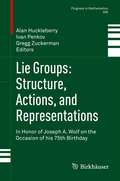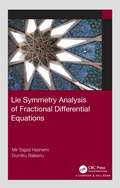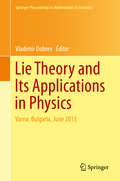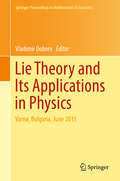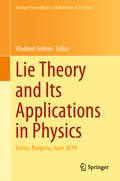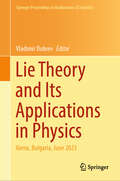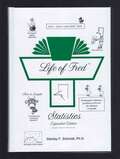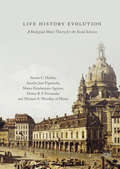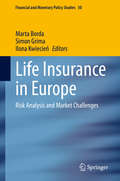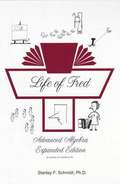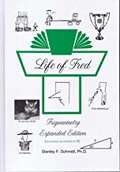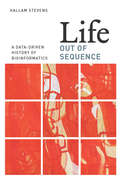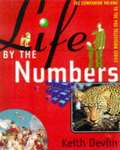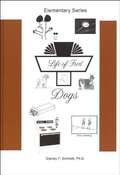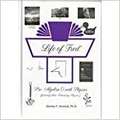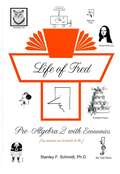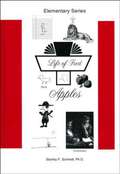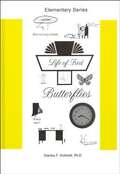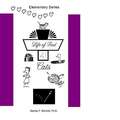- Table View
- List View
Lie Groups, Physics, and Geometry
by Robert GilmoreDescribing many of the most important aspects of Lie group theory, this book presents the subject in a 'hands on' way. Rather than concentrating on theorems and proofs, the book shows the applications of the material to physical sciences and applied mathematics. Many examples of Lie groups and Lie algebras are given throughout the text. The relation between Lie group theory and algorithms for solving ordinary differential equations is presented and shown to be analogous to the relation between Galois groups and algorithms for solving polynomial equations. Other chapters are devoted to differential geometry, relativity, electrodynamics, and the hydrogen atom. Problems are given at the end of each chapter so readers can monitor their understanding of the materials. This is a fascinating introduction to Lie groups for graduate and undergraduate students in physics, mathematics and electrical engineering, as well as researchers in these fields.
Lie Groups: In Honor of Joseph A. Wolf on the Occasion of his 75th Birthday
by Ivan Penkov Alan Huckleberry Gregg ZuckermanLie Groups: Structures, Actions, and Representations, In Honor of Joseph A. Wolf on the Occasion of his 75th Birthday consists of invited expository and research articles on new developments arising from Wolf's profound contributions to mathematics. Due to Professor Wolf's broad interests, outstanding mathematicians and scholars in a wide spectrum of mathematical fields contributed to the volume. Algebraic, geometric, and analytic methods are employed. More precisely, finite groups and classical finite dimensional, as well as infinite-dimensional Lie groups, and algebras play a role. Actions on classical symmetric spaces, and on abstract homogeneous and representation spaces are discussed. Contributions in the area of representation theory involve numerous viewpoints, including that of algebraic groups and various analytic aspects of harmonic analysis. Contributors D. Akhiezer T. Oshima A. Andrada I. Pacharoni M. L. Barberis F. Ricci L. Barchini S. Rosenberg I. Dotti N. Shimeno M. Eastwood J. Tirao V. Fischer S. Treneer T. Kobayashi C.T.C. Wall A. Korányi D. Wallace B. Kostant K. Wiboonton P. Kostelec F. Xu K.-H. Neeb O. Yakimova G. Olafsson R. Zierau B. Ørsted
Lie Symmetry Analysis of Fractional Differential Equations
by Dumitru Baleanu Mir Sajjad HashemiThe trajectory of fractional calculus has undergone several periods of intensive development, both in pure and applied sciences. During the last few decades fractional calculus has also been associated with the power law effects and its various applications. It is a natural to ask if fractional calculus, as a nonlocal calculus, can produce new results within the well-established field of Lie symmetries and their applications. In Lie Symmetry Analysis of Fractional Differential Equations the authors try to answer this vital question by analyzing different aspects of fractional Lie symmetries and related conservation laws. Finding the exact solutions of a given fractional partial differential equation is not an easy task, but is one that the authors seek to grapple with here. The book also includes generalization of Lie symmetries for fractional integro differential equations. Features Provides a solid basis for understanding fractional calculus, before going on to explore in detail Lie Symmetries and their applications Useful for PhD and postdoc graduates, as well as for all mathematicians and applied researchers who use the powerful concept of Lie symmetries Filled with various examples to aid understanding of the topics
Lie Theory and Its Applications in Physics
by Vladimir DobrevTraditionally, Lie Theory is a tool to build mathematical models for physical systems. Recently, the trend is towards geometrisation of the mathematical description of physical systems and objects. A geometric approach to a system yields in general some notion of symmetry which is very helpful in understanding its structure. Geometrisation and symmetries are meant in their broadest sense, i.e., classical geometry, differential geometry, groups and quantum groups, infinite-dimensional (super-)algebras, and their representations. Furthermore, we include the necessary tools from functional analysis and number theory. This is a large interdisciplinary and interrelated field. Samples of these new trends are presented in this volume, based on contributions from the Workshop "Lie Theory and Its Applications in Physics" held near Varna, Bulgaria, in June 2011. This book is suitable for an extensive audience of mathematicians, mathematical physicists, theoretical physicists, and researchers in the field of Lie Theory.
Lie Theory and Its Applications in Physics
by Vladimir DobrevTraditionally, Lie Theory is a tool to build mathematical models for physical systems. Recently, the trend is towards geometrisation of the mathematical description of physical systems and objects. A geometric approach to a system yields in general some notion of symmetry which is very helpful in understanding its structure. Geometrisation and symmetries are meant in their broadest sense, i. e. , classical geometry, differential geometry, groups and quantum groups, infinite-dimensional (super-)algebras, and their representations. Furthermore, we include the necessary tools from functional analysis and number theory. This is a large interdisciplinary and interrelated field. Samples of these new trends are presented in this volume, based on contributions from the Workshop "Lie Theory and Its Applications in Physics" held near Varna, Bulgaria, in June 2011. This book is suitable for an extensive audience of mathematicians, mathematical physicists, theoretical physicists, and researchers in the field of Lie Theory.
Lie Theory and Its Applications in Physics: Varna, Bulgaria, June 2019 (Springer Proceedings in Mathematics & Statistics #335)
by Vladimir DobrevThis volume presents modern trends in the area of symmetries and their applications based on contributions to the workshop "Lie Theory and Its Applications in Physics" held near Varna (Bulgaria) in June 2019. Traditionally, Lie theory is a tool to build mathematical models for physical systems. Recently, the trend is towards geometrization of the mathematical description of physical systems and objects. A geometric approach to a system yields in general some notion of symmetry, which is very helpful in understanding its structure. Geometrization and symmetries are meant in their widest sense, i.e., representation theory, algebraic geometry, number theory, infinite-dimensional Lie algebras and groups, superalgebras and supergroups, groups and quantum groups, noncommutative geometry, symmetries of linear and nonlinear partial differential operators, special functions, and others. Furthermore, the necessary tools from functional analysis are included. This is a large interdisciplinary and interrelated field. The topics covered in this volume from the workshop represent the most modern trends in the field : Representation Theory, Symmetries in String Theories, Symmetries in Gravity Theories, Supergravity, Conformal Field Theory, Integrable Systems, Polylogarithms, and Supersymmetry. They also include Supersymmetric Calogero-type models, Quantum Groups, Deformations, Quantum Computing and Deep Learning, Entanglement, Applications to Quantum Theory, and Exceptional Quantum Algebra for the standard model of particle physics This book is suitable for a broad audience of mathematicians, mathematical physicists, and theoretical physicists, including researchers and graduate students interested in Lie Theory.
Lie Theory and Its Applications in Physics: Varna, Bulgaria, June 2023 (Springer Proceedings in Mathematics & Statistics #473)
by Vladimir DobrevThis volume presents modern trends in the area of symmetries and their applications based on contributions to the workshop "Lie Theory and Its Applications in Physics" held in Sofia (Bulgaria) in June 2023. Traditionally, Lie theory is a tool to build mathematical models for physical systems. Recently, the trend is towards geometrization of the mathematical description of physical systems and objects. A geometric approach to a system yields in general some notion of symmetry, which is very helpful in understanding its structure. Geometrization and symmetries are meant in their widest sense, i.e., representation theory, algebraic geometry, number theory, infinite-dimensional Lie algebras and groups, superalgebras and supergroups, groups and quantum groups, noncommutative geometry, symmetries of linear and nonlinear partial differential operators, special functions, and others. Furthermore, the necessary tools from functional analysis are included. This is a large interdisciplinary and interrelated field. The topics covered in this volume from the workshop represent the most modern trends in the field: Representation Theory, Symmetries in String Theories, Symmetries in Gravity Theories, Supergravity, Conformal Field Theory, Integrable Systems, Polylogarithms, and Supersymmetry. They also include Supersymmetric Calogero-type models, Quantum Groups, Deformations, Quantum Computing and Deep Learning, Entanglement, Applications to Quantum Theory, and Exceptional Quantum Algebra for the standard model of particle physics This book is suitable for a broad audience of mathematicians, mathematical physicists, and theoretical physicists, including researchers and graduate students interested in Lie Theory.
Life 0f Fred Statistics: Expanded Edition
by Stanley F. SchmidtA year of college statistics. All the answers are given in the book itself. No need to buy answer keys, teachers' editions, or anything else. Descriptive Statistics (averages, measures of dispersion, types of distributions), Probability, Bayes’ Theorem, From a Given Population Determine What Samples Will Look Like (7 tests), Techniques of Sampling, From a Given Sample Determine What the Population Was (14 tests), Determine Whether Two Given Samples Came From the Same Population (15 tests), Working With Three or More Samples (10 tests), Emergency Statistics Guide, Regression Equations, Field Guide, 16 Tables. (College level.) Hardback, 576 pages.
Life History Evolution: A Biological Meta-Theory for the Social Sciences
by Steven C. Hertler Aurelio José Figueredo Mateo Peñaherrera-Aguirre Michael A. Woodley of Menie Heitor B. FernandesThe social sciences share a mission to shed light on human nature and society. However, there is no widely accepted meta-theory; no foundation from which variables can be linked, causally sequenced, or ultimately explained. This book advances “life history evolution” as the missing meta-theory for the social sciences. Originally a biological theory for the variation between species, research on life history evolution now encompasses psychological and sociological variation within the human species that has long been the stock and trade of social scientific study. The eighteen chapters of this book review six disciplines, eighteen authors, and eighty-two volumes published between 1734 and 2015—re-reading the texts in the light of life history evolution.
Life Insurance in Europe: Risk Analysis and Market Challenges (Financial and Monetary Policy Studies #50)
by Simon Grima Marta Borda Ilona KwiecieńThis book examines the challenges for the life insurance sector in Europe arising from new technologies, socio-cultural and demographic trends, and the financial crisis. It presents theoretical and applied research in all areas related to life insurance products and markets, and explores future determinants of the insurance industry’s development by highlighting novel solutions in insurance supervision and trends in consumer protection. Drawing on their academic and practical expertise, the contributors identify problems relating to risk analysis and evaluation, demographic challenges, consumer protection, product distribution, mortality risk modeling, applications of life insurance in contemporary pension systems, financial stability and solvency of life insurers. They also examine the impact of population aging on life insurance markets and the role of digitalization. Lastly, based on an analysis of early experiences with the implementation of the Solvency II system, the book provides policy recommendations for the development of life insurance in Europe.
Life Of Fred Trigonometry, Expanded Edition
by Stanley F. SchmidtLife of Fred is a series of math books that break the old pattern of drill and kill. Instead of nothing but dry exposition and endless drill exercises, they contain fun stories about Fred Gauss, a child prodigy math genius. During his hilarious adventures, he encounters situations that call for solving math problems. Dr. Stanley Schmidt wrote these to make math come alive with humor, clear explanations, and silly illustrations that will make math a fun subject. Your children actually want to read these books. The stories carry on through the exercises, leading the student through them.
Life Of Fred: Edgewood
by Stanley F. SchmidtThe idea behind Life of Fred is that if students have an enjoyable experience and have fun doing their math, they will remember it and use it and have a good taste in their math about the whole subject. The sub-title on each of his math books is "As Serious As it Needs to Be". And that is just the point: math doesn't need to be horrid and dry. This is math-just as serious as it needs to be-and I can tell you from Louisa's smiles and chuckles, that's not very serious at all! As a bonus, these books are very low priced compared to any other math books on the market. (Compare to Saxon at 50-70). If you have a creative child who is languishing on traditional math programs, try Life of Fred! Math, As Serious As it Needs to Be! If you know your math facts (addition and multiplication) and you can read well, then the next step is to get to know Fred! <P><P> Beware: This is not a traditional math book. This is a child-directed course. The student reads the adventure story, does the math problems that occur as a natural part of the story, and checks their answers (the solutions are right there for the looking.) And learns to love math in the process! You will not get the detailed formula explanations that you get in a traditional math book. I am still amazed that kids can read the story and learn the concepts, but they do!
Life Out of Sequence: A Data-Driven History of Bioinformatics
by Hallam StevensThirty years ago, the most likely place to find a biologist was standing at a laboratory bench, peering down a microscope, surrounded by flasks of chemicals and petri dishes full of bacteria. Today, you are just as likely to find him or her in a room that looks more like an office, poring over lines of code on computer screens. The use of computers in biology has radically transformed who biologists are, what they do, and how they understand life. In "Life Out of Sequence," Hallam Stevens looks inside this new landscape of digital scientific work. aaaaaaaaaaaStevens chronicles the emergence of bioinformaticsOCothe mode of working across and between biology, computing, mathematics, and statisticsOCofrom the 1960s to the present, seeking to understand how knowledge about life is made in and through virtual spaces. He shows how scientific data moves from living organisms into DNA sequencing machines, through software, and into databases, images, and scientific publications. What he reveals is a biology very different from the one of predigital days: a biology that includes not only biologists but also highly interdisciplinary teams of managers and workers; a biology that is more centered on DNA sequencing, but one that understands sequence in terms of dynamic cascades and highly interconnected networks. "Life Out of Sequence "thus offers the computational biology community welcome context for their own work while also giving the public a frontline perspective of what is going on in this rapidly changing field. "
Life and Job Satisfaction in China: Exploring Longitudinal Analysis with Mplus (Quality of Life in Asia #19)
by Lukasz Czarnecki Delfino Vargas ChanesThis book examines subjective wellbeing in China in terms of life and job satisfaction from a longitudinal perspective during the last decade. Using quantitative methods, the research presented in this volume performed a longitudinal analysis of data collected by the China Family Panel Studies (CFPS) from 2010 to 2018 to study the effects of social and economic transformations on life and job satisfaction among the Chinese population in this period. Using Mplus software, the authors applied different quantitative methods of longitudinal analysis – such as latent growth models (LGM), latent growth mixture model (LGMM), parallel analysis, cross-lagged models (CL), latent change score (LCS), and multilevel longitudinal models (MLM) – to explore the trajectory of three variables on the CFPS data between 2010 and 2018: life satisfaction, job satisfaction and the interplay between job and life satisfaction. The results reveal a process of growing inequalities between life and job satisfaction among the Chinese population over time. Life and Job Satisfaction in China: Exploring Longitudinal Analysis with Mplus will be of interest to sociologists, statisticians and applied researchers interested in applying quantitative methods to develop longitudinal studies of quality of life in China.
Life by the Numbers
by Keith J. DevlinThis companion to the PBS television series offers illustrated proof that mathematics is a vital and creative way of thinking and seeing, without using a single mathematical equation. Explores the range of ways in which scientists, artists, athletes, medical researchers, and others are using mathematics, and profiles present-day male and female pioneers in mathematics and science. Discussions ranging from deep-sea volcanoes to movie special effects and wearable computers are illustrated with color photos and drawings. For general readers high school and up. [This text is listed as an example that meets Common Core Standards in English language arts in grades 9-10 at http://www.corestandards.org.]
Life of Fred Logic
by Stanley F. Schmidt"Logic with all the standard topics: Propositional and Predicate Logic; 17 Logical Fallacies; Gödel's Theorems and Diagonalization Lemma Proved; Metamathematics; Life Insurance for Fred's Wife"--Back cover.
Life of Fred Pre-Algebra 0 with Physics (Life of Fred Series)
by Stanley F. SchmidtThere is a Your Turn to Play at the end of each chapter/lesson. Please write out the answers on paper before you look at the Complete Solutions offered on the next page. It will help you to learn. Students who do this often do much better on the Bridges that come at the end of every six chapters. Get a sheet of paper and head it with Formulas. If your handwriting is really good, Formulas. If your handwriting isn't so good, Formulas. You will not be graded on your handwriting skills. Write down each formula that you encounter in the book and draw a little picture. Each chapter is a lesson--40 chapters and six Bridges to cross. Enjoy your journey with Fred.
Life of Fred: Apples
by Stanley F. SchmidtThis book covers beginning mathematics including: Numbers that Add to 7, Circles, Ellipses, Reading a Clock, 5 + ? = 7, Days of the Week, Leap Years, Spelling February, 15 Degrees Below Zero (-15º), Counting by Fives, 3x + 4x = 7x, ante meridiem (a.m.), One Million Squares, The "There Are Zero . . ." Game Sets, the Popularity of Zero Triangles, (not equal), x + 4 = 7, One Thousand, Counting by Hundreds, Rectangles, and much more . . .
Life of Fred: Beginning Algebra
by Stanley SchmidtAnnotation. All the popular tests plus many advanced tests plus regression equations including Logistic Regression. An "Emergency Statistics Guide" (unique to this book) to instantly find which test to use. Designed for self-study or classroom use. Tons of examples and easy-to-understand tables. Readers should have had algebra and own a regular science calculator with square root and LOG keys on it. No computer or graphing calculator required. An easy-to-use reference book for researchers needing statistics in their work.
Life of Fred: Calculus
by Stanley F. SchmidtAll of Calculus! Sixteen college semester units including: Multi-variable Calculus Analytic Geometry Vector Calculus Differential Equations All fun! Just open & enjoy. Functions, Limits, Speed, Slope, Derivatives, Concavity, Trig, Related Rates, Curvature, Integrals, Area, Work, Centroids, Logs, Conics, Infinite Series, Solids of Revolution, Polar Coordinates, Hyperbolic Trig, Vectors, Partial Derivatives, Double Integrals, Vector Calculus, Differential Equations. This expanded edition includes all answers!
Life of Fred: Cats
by Stanley F. SchmidtBook three in the series of books designed to make your child think and to learn on their own. Unlike other programs, the Life of Fred series focuses on reading comprehension and thinking, not rote spoon-fed learning that is soon forgotten. Upon completion students will understand how math works, why it works, and how to apply it.

